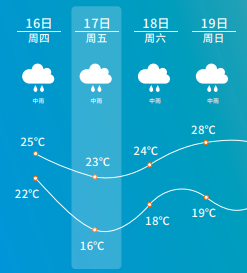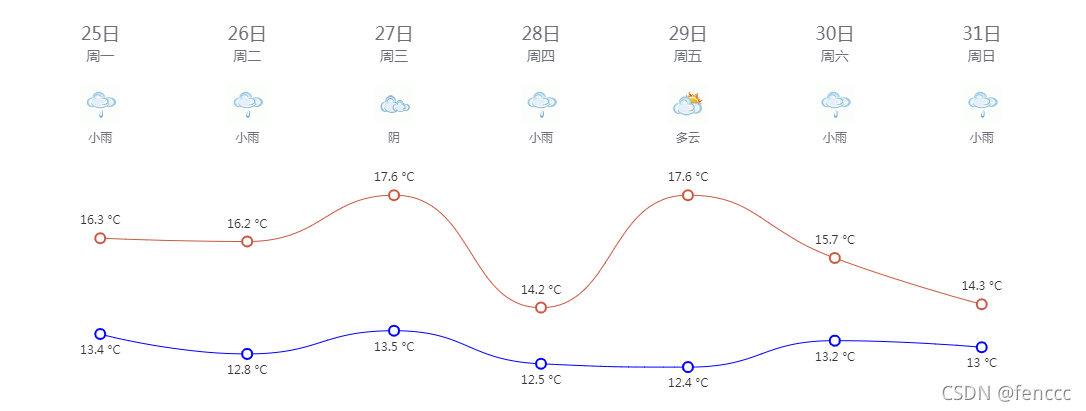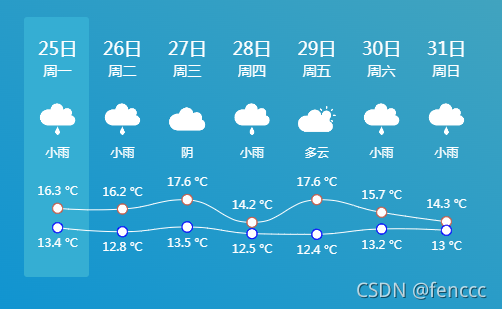目录
- UI设计图
- Echarts示例效果
- 前言
- 示例代码
- 最终效果
UI设计图

Echarts示例效果

前言
对于UI给出的设计图,各个气象网站都有类似的效果,实现方式大可归为两种:
- 网格布局+图表框架绘制温度曲线;
- 网格布局+canvas自绘温度曲线;
这两种实现方式的共同点都是将曲线和上面的描述文字拆分开来,这样做难点是要实现日期图标部分和气温曲线部分的自适应对齐。因为我CSS经验相对比较薄弱,并且使用Echarts图表框架相对较多,所以决定尝试使用Echarts(版本:4.6.0)来实现上面的效果。查看文档后发现Echarts支持多X轴和富文本显示,可以通过调整X轴偏移量来控制显示位置,同时富文本支持设置背景图标,可以用来显示天气图标。一番测试后得到下面的示例代码。
示例代码
下面这段代码可以考入Echarts直接运行:
var option = {
grid: {
show: true,
backgroundColor: 'transparent',
opacity: 0.3,
borderWidth: '0',
top: '180',
bottom: '0'
},
tooltip: {
trigger: 'axis'
},
legend: {
show: false
},
xAxis: [
// 日期
{
type: 'category',
boundaryGap: false,
position: 'top',
offset: 130,
zlevel: 100,
axisLine: {
show: false
},
axisTick: {
show: false
},
axisLabel: {
interval: 0,
formatter: [
'{a|{value}}'
].join('\n'),
rich: {
a: {
// color: 'white',
fontSize: 18
}
}
},
nameTextStyle: {
},
data: ["25日","26日","27日","28日","29日","30日","31日"]
},
// 星期
{
type: 'category',
boundaryGap: false,
position: 'top',
offset: 110,
zlevel: 100,
axisLine: {
show: false
},
axisTick: {
show: false
},
axisLabel: {
interval: 0,
formatter: [
'{a|{value}}'
].join('\n'),
rich: {
a: {
// color: 'white',
fontSize: 14
}
}
},
nameTextStyle: {
fontWeight: 'bold',
fontSize: 19
},
data: ["周一","周二","周三","周四","周五","周六","周日"]
},
// 天气图标
{
type: 'category',
boundaryGap: false,
position: 'top',
offset: 20,
zlevel: 100,
axisLine: {
show: false
},
axisTick: {
show: false
},
axisLabel: {
interval: 0,
formatter: function(value, index) {
return '{' + index + '| }\n{b|' + value + '}'
},
rich: {
0: {
backgroundColor: {
// image: require('@/assets/weather_icon/' + this.weatherIconDic[this.weatherdata.weather[0]] + '.png')
image: 'https://d.scggqx.com/forecast/img/小雨.png'
},
height: 40,
width: 40
},
1: {
backgroundColor: {
// image: require('@/assets/weather_icon/' + this.weatherIconDic[this.weatherdata.weather[1]] + '.png')
image: 'https://d.scggqx.com/forecast/img/小雨.png'
},
height: 40,
width: 40
},
2: {
backgroundColor: {
// image: require('@/assets/weather_icon/' + this.weatherIconDic[this.weatherdata.weather[2]] + '.png')
image: 'https://d.scggqx.com/forecast/img/阴.png'
},
height: 40,
width: 40
},
3: {
backgroundColor: {
// image: require('@/assets/weather_icon/' + this.weatherIconDic[this.weatherdata.weather[3]] + '.png')
image: 'https://d.scggqx.com/forecast/img/小雨.png'
},
height: 40,
width: 40
},
4: {
backgroundColor: {
// image: require('@/assets/weather_icon/' + this.weatherIconDic[this.weatherdata.weather[4]] + '.png')
image: 'https://d.scggqx.com/forecast/img/多云.png'
},
height: 40,
width: 40
},
5: {
backgroundColor: {
// image: require('@/assets/weather_icon/' + this.weatherIconDic[this.weatherdata.weather[5]] + '.png')
image: 'https://d.scggqx.com/forecast/img/小雨.png'
},
height: 40,
width: 40
},
6: {
backgroundColor: {
// image: require('@/assets/weather_icon/' + this.weatherIconDic[this.weatherdata.weather[6]] + '.png')
image: 'https://d.scggqx.com/forecast/img/小雨.png'
},
height: 40,
width: 40
},
b: {
// color: 'white',
fontSize: 12,
lineHeight: 30,
height: 20
}
}
},
nameTextStyle: {
fontWeight: 'bold',
fontSize: 19
},
// data: this.weatherdata.weather
data: ["小雨","小雨","阴","小雨","多云","小雨","小雨"]
}
],
yAxis: {
type: 'value',
show: false,
axisLabel: {
formatter: '{value} °C',
color: 'white'
}
},
series: [
{
name: '最高气温',
type: 'line',
data: ["16.3","16.2","17.6","14.2","17.6","15.7","14.3"],
symbol: 'emptyCircle',
symbolSize: 10,
showSymbol: true,
smooth: true,
itemStyle: {
normal: {
color: '#C95843'
}
},
label: {
show: true,
position: 'top',
// color: 'white',
formatter: '{c} °C'
},
lineStyle: {
width: 1,
// color: 'white'
},
areaStyle: {
opacity: 1,
color: 'transparent'
}
},
{
name: '最低气温',
type: 'line',
data: ["13.4","12.8","13.5","12.5","12.4","13.2","13"],
symbol: 'emptyCircle',
symbolSize: 10,
showSymbol: true,
smooth: true,
itemStyle: {
normal: {
color: 'blue'
}
},
label: {
show: true,
position: 'bottom',
// color: 'white',
formatter: '{c} °C'
},
lineStyle: {
width: 1,
// color: 'white'
},
areaStyle: {
opacity: 1,
color: 'transparent'
}
}
]
}
上面的代码,最难的部分就是天气图标的设置,由于axisLabel的formatter方法中的value值没法在富文本中使用,所以这里在formatter方法中将value的下标设置成了富文本中的css名,然后在设置天气图标时使用下标获取需要显示的图标名称。
// axisLabel的formatter方法
formatter: function(value, index) {
return '{' + index + '| }\n{b|' + value + '}'
}
// axisLabel的rich方法
rich: {
index: {
backgroundColor: {
image: require('@/assets/weather_icon/' + this.weatherIconDic[this.weatherdata.weather[index]] + '.png')
},
height: 40,
width: 40
}
}
注:
1、this.weatherIconDic是我本地定义的一个天气图标的数据字典。(如:{ ‘晴': ‘a00', ‘多云': ‘a01', ‘阴': ‘a02', ‘阵雨': ‘a03', ‘雷阵雨': ‘a04', ‘冰雹': ‘a05', ‘雨夹雪': ‘a06', ‘小雨': ‘a07', ‘中雨': ‘a08', ‘大雨': ‘a09', ‘暴雨': ‘a10', ‘大暴雨': ‘a11', ‘特大暴雨': ‘a12', ‘阵雪': ‘a13', ‘小雪': ‘a14', ‘中雪': ‘a15', ‘大雪': ‘a16', ‘暴雪': ‘a17', ‘雾': ‘a18', ‘冻雨': ‘a19', ‘沙尘暴': ‘a20', ‘小到中雨': ‘a21', ‘中雨-大雨': ‘a22', ‘大雨-暴雨': ‘a23', ‘暴雨-大暴雨': ‘a24', ‘大暴雨-特大暴雨': ‘a25', ‘小雪-中雪': ‘a26', ‘中雪-大雪': ‘a27', ‘大雪-暴雪': ‘a28', ‘浮尘': ‘a29', ‘扬沙': ‘a30', ‘强沙尘暴': ‘a31' })
2、this.weatherdata.weather是后端传回来的天气类型。(如:[“小雨”,“小雨”,“阴”,“小雨”,“多云”,“小雨”,“小雨”])
最终效果

到此这篇关于Echarts利用多X轴实现七天天气预报效果的示例代码的文章就介绍到这了,更多相关Echarts 多X轴天气预报内容请搜索自由互联以前的文章或继续浏览下面的相关文章希望大家以后多多支持自由互联!
